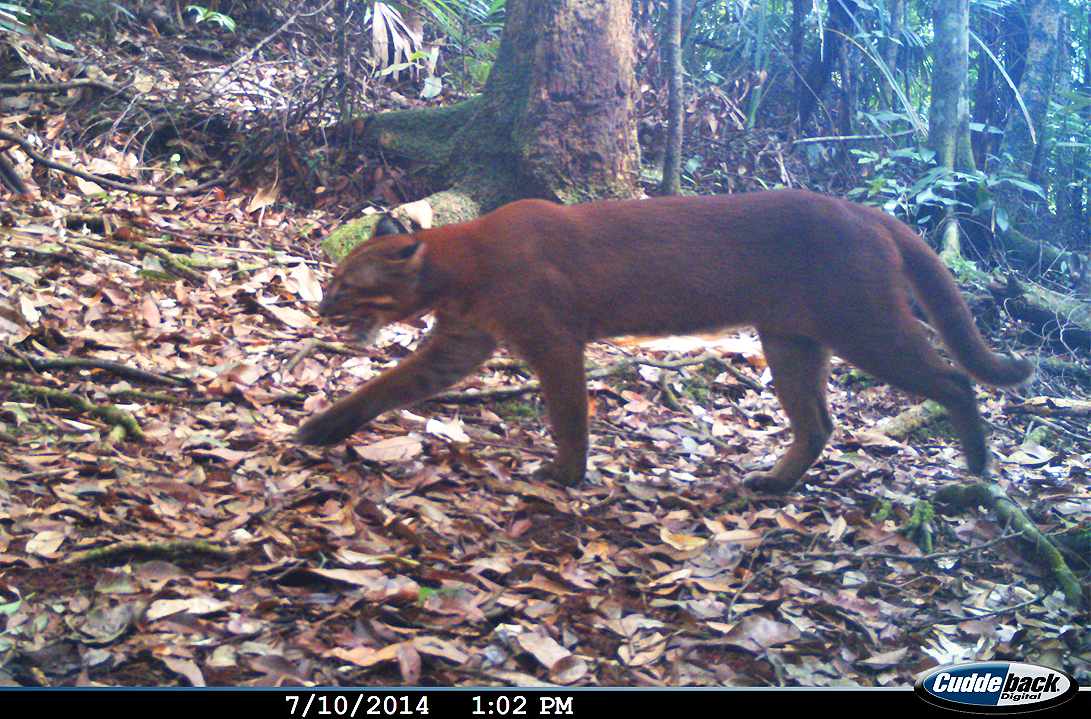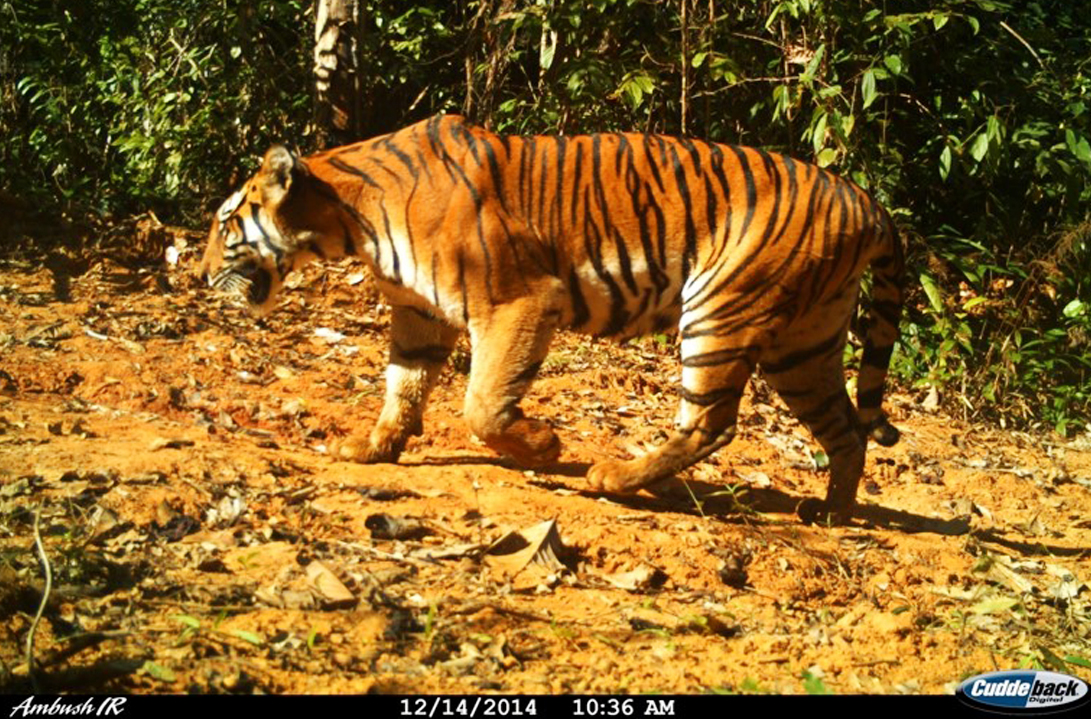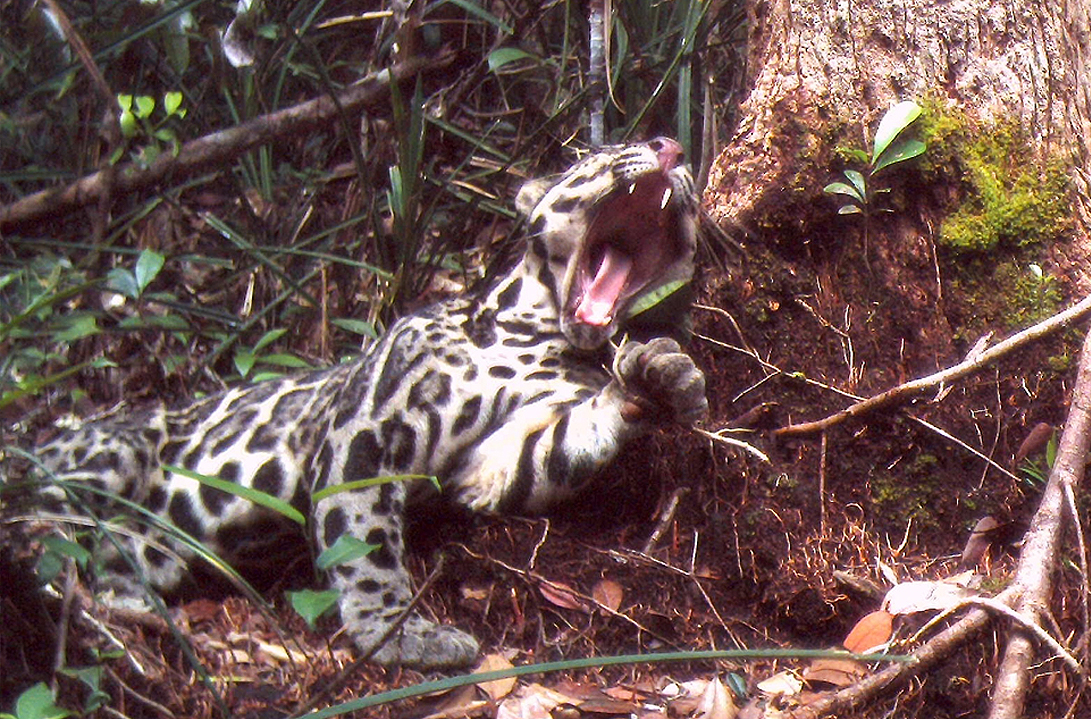Beginning with field studies of the Sunda clouded leopard in Borneo in 2010, the programme integrates ecological and behavioural research with advanced spatial modelling for the development and dissemination of policy planning tools. Drawing on WildCRU’s extensive camera trap surveys, spanning both the mainland Neofelis nebulosa, and the Sunda Neofelis diardi and the other species of felids coexisting with them, for example, tigers and leopard, this work aims to positively impact their populations and the associated biodiversity.
CONSERVATION CONTEXT
Increasing loss and fragmentation of habitats paired with limited resources for conservation has resulted in an urgent need to identify and prioritize the most important areas for conservation that also maintain and enhance ecological connectivity. The mainland and Sunda clouded leopards are threatened with extinction throughout their current ranges primarily due to anthropogenic pressures such as deforestation and hunting. Our landscape team are leaders in modelling species distributions and landscape processes, providing the most robust connectivity and habitat models.
Empirical data from over 10 years of camera trapping across Southeast Asia, as well as movement data from collared Sunda clouded leopard in Sabah, underpin our habitat suitability models. These models provide scientific evidence to support complex decisions faced by land-use planners – the dilemma of balancing the demands of human population growth and economic development with that of preserving critical ecosystems and biodiversity conservation. Our goal is to make this information available for policy makers and other stakeholders in a Decision Support System which revolutionises access to conservation landscape planning tools in an intuitive, user-friendly, web-based dashboard.

Golden cat

Tiger

The team

Sunda clouded leopard in Kalimantan
APPROACH
Landscape connectivity Decision Support System
WildCRU, in partnership with University of Arizona and supported by NASA, has facilitated the development of a web-based Decision Support System (DSS) that uses cutting edge modelling to quantify landscape connectivity for a wide range of priority species. Currently the functionality of the DSS relies upon existing species distribution models or habitat suitability models. Existing models are either uploaded by end-users, or alternatively demonstration models based on WildCRU research from the region are available. The automated software calculates connectivity and ranks core areas and corridors that are most important for target species under current and proposed land use scenarios. For example, connectivity and rank of core areas and corridors can be re- calculated to assess the impact of an additional protected area, or a new infrastructure development. These results are displayed on a map window in the DSS and can be downloaded as spatial files. Spatially explicit population genetic modelling is also available in the dashboard. The system is expected to enhance inter-agency collaboration and improve geographical prioritization of existing and planned activities related to protected areas and other land use change scenarios. The modelling approach developed by our Southeast Asia felid team is being applied in other WildCRU programmes, including for the Trans Kalahari Predator Programme and Scottish wildcat Programme.
Simulating species recovery
While viable populations of clouded leopards may remain in some regions, others have undergone catastrophic declines and the mainland species has probably been extirpated from Vietnam, most of China, and Taiwan. However, with decades-long hunting restriction and forest restoration, many of Taiwan’s large mammals are thought to be recovering, which highlights the possibility of reintroducing the clouded leopard to Taiwan. Research led by our DPhil student, Yi-Feng Wang, represents the first comprehensive effort to explore the feasibility of their recovery. Building out from our camera survey data across the existing range, our habitat models indicate that 38% of Taiwanese territory is potentially suitable habitat for the clouded leopard, of which 46% is under protection. We are simulating recovery of other species including tigers, Arabian leopards and Indochinese leopards using population genetic and connectivity modelling approaches.
Behavioural ecology
In our long term study on Sabah, Malaysian Borneo in addition to camera trapping, we live-trap Sunda clouded leopard so that we can fit satellite collars and sample their blood to inform our understanding of their behavioural ecology and genetics. We have employed state-of-the-art genomic sequencing technology and have produced the first genomic assemblies of wild-caught Sunda clouded leopards led by doctoral student, Chrishen Gomez. We survey little known species from the region such as Bornean ferret badger in the Western mountain massif and the flat-headed cat in Brunei. We are using our extensive camera trap database from across the whole Southeast Asia region, which has amassed more than 2 million images, to understand the habitat relationships for small felids such as golden cat, marbled cat and leopard cat, other carnivores and also prey communities.
PROGRAMME IMPACT HIGHLIGHTS
The programme has amassed a camera trap database arising from 5,531 stations, from 9 countries resulting in over 2 million (2,064,576) photographic records.
Decision support system deployed in 6 countries during 2024 (Brunei, Sabah, Taiwan, Thailand, Myanmar, Laos, Indonesia)
We have sequenced a total of 13 wild Sunda clouded leopard genomes
4-part video playlist from the programme
(Use the playlist icon top right to select videos)
PROGRAMME MEMBERS
WildCRU’s David Macdonald leads the programme, Dawn Burnham is programme coordinator. Sam Cushman leads the spatial modelling. Carol Sartor and Andrew Hearn are researchers. Chrishen Gomez and Leo (Yi Feng) Wang are current DPhil students. Past researchers and students in the Southeast Asia felid programme include Zaneta Kaszta, Jan Kamler, Eric Ash, Luca Chiaverini, Susana Rostro, Akchousanh Rasphone, Iding Haidir, Ugyen Penjor, Luciano Atzeni, Mohammad Farhadinia, Pyae Phyoe Kyaw, Cedric Tan, Susan Cheyne, Saw Htun, Hla Naing, Amy Fitzmaurice.

